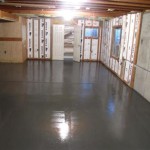How Much Value Does a Finished Basement Add?
The question of how much value a finished basement adds to a property is a multifaceted one, heavily reliant on various factors ranging from location and market conditions to the quality of the renovation itself. A finished basement can significantly enhance a home's livable space, potentially increasing its resale value. However, understanding the nuances and considering the potential return on investment (ROI) is crucial before embarking on such a project.
The perceived value of a finished basement varies across different regions. In areas where housing prices are high and square footage is at a premium, adding finished space below grade can be a worthwhile investment. Conversely, in regions where land is more readily available and above-ground living space is less expensive, the impact on property value might be less pronounced. The local real estate market, current housing trends, and buyer preferences all play a significant role in determining the actual value added.
Moreover, the quality of the basement finishing is paramount. A poorly executed renovation can actually detract from the overall value of the home. Issues such as inadequate waterproofing, low ceiling heights, insufficient lighting, and subpar finishes can turn a potential asset into a liability. A well-designed and properly implemented basement finishing project, on the other hand, can create a valuable and desirable living space.
Location, Location, Location: The Impact of Geography
Geographic location exerts a considerable influence on the value that a finished basement contributes to a property. In densely populated urban areas where available land is scarce and housing costs are high, buyers often place a greater premium on usable square footage, regardless of whether it's above or below grade. In these markets, a finished basement can represent a significant increase in the home's total living space, thereby substantially boosting its market value.
For example, in cities like New York or San Francisco, where square footage is at a premium, a finished basement can effectively double the living space of a smaller home, making it significantly more attractive to potential buyers. This is especially true for families looking for more room to grow without having to move to a larger, more expensive property.
Conversely, in suburban or rural areas where land is more affordable and homes tend to be larger, the addition of a finished basement may not have as dramatic an impact on the property's overall value. Buyers in these areas may prioritize above-ground living space and outdoor amenities, such as large yards or decks, over finished basements. The demand for additional indoor space may be lower, which can translate to a smaller return on investment for a basement finishing project.
Furthermore, the climate in a particular region can also affect the perceived value of a finished basement. In areas with harsh winters or hot summers, a well-insulated and climate-controlled basement can provide a comfortable and usable living space year-round, adding to its appeal. In contrast, in areas with mild climates, the need for additional indoor space may be less pronounced, reducing the premium that buyers are willing to pay for a finished basement.
Quality of Renovation: The Key to Maximizing Value
The quality of the basement finishing is arguably the most important factor in determining how much value it adds to a home. A poorly executed renovation can actually decrease the property's value, while a well-designed and professionally implemented project can significantly enhance its appeal and marketability. The basement needs to be more than just a hastily enclosed space; it requires careful planning and execution to meet building codes and buyer expectations.
One of the most crucial aspects of a high-quality basement renovation is waterproofing. Basements are inherently susceptible to moisture problems, and inadequate waterproofing can lead to issues such as mold growth, structural damage, and unpleasant odors. Investing in proper waterproofing measures, such as interior or exterior sealing, sump pumps, and French drains, is essential to prevent these problems and ensure the long-term integrity of the finished space.
Another important consideration is ceiling height. Low ceilings can make a basement feel cramped and uncomfortable, significantly diminishing its appeal to potential buyers. Ideally, the finished basement should have a ceiling height of at least seven feet, and preferably eight feet or more, to create a more open and inviting space. If the existing ceiling height is too low, options such as underpinning (lowering the basement floor) may be necessary, although these can be costly and complex.
Lighting and ventilation are also critical factors. Basements tend to be dark and poorly ventilated, so it's important to incorporate ample lighting, both natural and artificial, to create a bright and airy atmosphere. Installing egress windows or window wells can provide natural light and ventilation, as well as serve as emergency exits. Proper ventilation is also essential to prevent moisture buildup and improve air quality.
Finally, the quality of the finishes and fixtures used in the renovation can significantly impact the perceived value of the finished basement. Opting for durable, high-quality materials, such as waterproof flooring, moisture-resistant drywall, and energy-efficient appliances, can enhance the space's appeal and functionality. Attention to detail, such as professional painting, well-designed lighting fixtures, and stylish hardware, can further elevate the overall look and feel of the finished basement.
Market Trends and Buyer Preferences: Understanding Demand
The overall real estate market and prevailing buyer preferences also influence the value added by a finished basement. What buyers seek in a home and the current market dynamics can significantly impact the demand and, consequently, the value they place on a finished basement.
During periods of economic growth and rising home prices, buyers often have more discretionary income and are willing to pay a premium for desirable features, such as finished basements. In a seller's market, where demand exceeds supply, a finished basement can be a significant selling point, attracting multiple offers and driving up the final sale price.
Conversely, during economic downturns or in buyer's markets, where supply exceeds demand, buyers may be more price-sensitive and less willing to pay extra for finished basements. In these situations, the added value of a finished basement may be less pronounced, and sellers may need to offer price concessions or incentives to attract buyers.
Buyer preferences also play a crucial role. Different buyers have different needs and priorities when it comes to housing. Some buyers may prioritize a large, open-concept living area, while others may value a dedicated home office, a media room, or a recreational space for children. A finished basement can be customized to meet these specific needs and preferences, making the home more attractive to a wider range of buyers.
For example, a finished basement with a home theater and a wet bar might appeal to buyers who enjoy entertaining, while a basement with a home office and a gym might be attractive to professionals who work from home or prioritize fitness. The key is to understand the target market and tailor the basement finishing to meet their specific needs and desires.
In addition to the functional aspects of a finished basement, its aesthetic appeal can also influence buyer preferences. A well-designed and tastefully decorated basement can create a welcoming and inviting atmosphere, making the home more memorable and desirable. Conversely, a poorly designed or outdated basement can detract from the overall appeal of the property and reduce its market value.
It is recommended to consult with a local real estate agent to gauge current market trends and buyer preferences in the specific area. This will help to ensure that the basement finishing project is aligned with market demand and maximizes its potential to add value to the property.
Ultimately, determining the value of a finished basement requires comprehensive analysis of the local real estate market, the quality of the renovation, and the prevailing buyer preferences. While hard numbers are difficult to specify without a market-specific appraisal, understanding the factors at play allows homeowners to make informed decisions regarding their renovation investments.

Here S How Much Value A Finished Basement Really Adds

Finished Basements Ideas Costs And Added Value Explained

How Much Value Does A Finished Basement Add

Does A Finished Basement Add Value Daniels Design Remodeling Ddr

8 Surprising Ways To Add Value Your Home With A Finished Basement

How Much Can A Finished Basement Add To Your Home S Value

How Much Value A Finished Basement Can Add To Your Home

Will A Finished Basement Add Value To My Home Columbus Real Estate Blog

Should You Finish Your Basement To Sell For More Curbio

Does A Finished Basement Adds Value Harmony Basements
See Also








